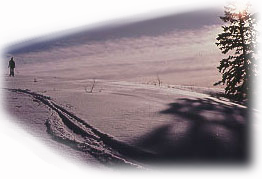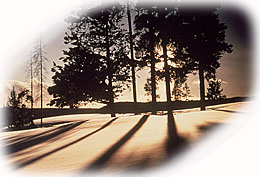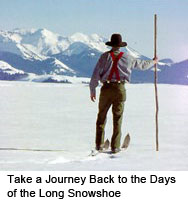This really isn't a story, rather it's a short essay piece on winter. Writers and poets invariably denigrate the wintertime, but if you're like me, you look forward to winter. Let the poets whine and stew in their melancholy. We would rather celebrate: Arrives the snow!
Near the end of the summer, we first start thinking about it. As fall comes, and the leaves turn and swirl in colorful whirlwinds, we eagerly look forward to it. Then it happens. It snows--and that first day of snow is a cause for celebration . . .
Announced by all the trumpets of the sky,
Arrives the snow. --Ralph Waldo Emerson
It's all about snow, isn't it? Snow and all its marvelous variations. It makes skiing and snowshoeing possible, of course, but snow also adds a rich aesthetic element that makes winter sport much more than simply recreation, but rather something more akin to art. I think that, deep down, those who enjoy the winter love and appreciate art, most particularly, the art of the natural world. What is more beautiful than snow? It's that aesthetic element that many in contemporary society miss, for unless you ski or snowshoe, or really spend time in the snow, you never have the opportunity to truly see it.
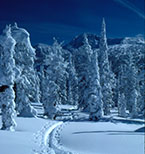 We all had those times, burned into our memory, when we've truly have experienced beauty, those glorious times when we're out on skis or snowshoes, and the sun comes out, and the snow-draped world suddenly becomes mystical and magical and everything is so bright and beautiful that you just want it to last and last. That is a part of understanding art: of seeking it, finding it, appreciating it, and wanting to hold onto to it as long as we can.
We all had those times, burned into our memory, when we've truly have experienced beauty, those glorious times when we're out on skis or snowshoes, and the sun comes out, and the snow-draped world suddenly becomes mystical and magical and everything is so bright and beautiful that you just want it to last and last. That is a part of understanding art: of seeking it, finding it, appreciating it, and wanting to hold onto to it as long as we can.
The first time I can recall that I had one of these experiences was on a multi-day ski journey. I was a new skier and had only skied a few times prior to the trip. At the time I was mostly a climber, and some college friends had invited me along to do a winter climb during Christmas break. To get to the base of the climb meant a two-day trip and it meant using cross-country skis.
It was one of those trips where you have to learn by immersion. I don't know how many times I fell that first day--forward, backward and sideways--landing in all sorts of contorted positions. I learned plenty: I learned that you don't step across your skis when you change directions; that with a pack on your back, you don't do a lot of extraneous back and forth motions with the upper body; and that when you get up after a fall, the only way to do it is to remove the pack first, then get up.
 The first night we found a flat place, packed down the snow with skis, and set up the tent. It was late December and nightfall came quickly, and shortly thereafter came a nearly full moon. After we had gotten settled, wrapped ourselves in our bags for warmth, and had eaten a meal while propped up on elbows, someone suggested a moonlight ski. A moonlight ski. What a novel idea! I eagerly joined them, and that's when the beauty of snow really hit me. Stepping out of the tent was like stepping into a vast art gallery with one grand surrealistic painting.
The first night we found a flat place, packed down the snow with skis, and set up the tent. It was late December and nightfall came quickly, and shortly thereafter came a nearly full moon. After we had gotten settled, wrapped ourselves in our bags for warmth, and had eaten a meal while propped up on elbows, someone suggested a moonlight ski. A moonlight ski. What a novel idea! I eagerly joined them, and that's when the beauty of snow really hit me. Stepping out of the tent was like stepping into a vast art gallery with one grand surrealistic painting.
That night I skied through a world of broad brush strokes and blue light and glitter and shadows. What is there about snow at night that is so surrealistic? It's unreal, like no place on earth, more like a dream than anything familiar or tangible. We kept mostly to the open areas, taking advantage of the light of the moon, skiing up gentle inclines and around mounds where small trees had been drifted over. I stayed out longer than the others, thoroughly enjoying the silence and the snow, which was perfect that night, light and fluffy and forgiving--even when, yet again, I crossed a ski and tumbled forward.
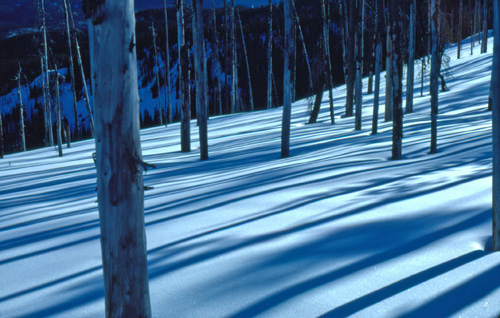
It takes special moments like these to remind us that the beauty of snow goes deeper than the surface. That's particularly so when you live in snow country, for it's easy to take the white stuff for granted. Snow has always been a constant throughout my life. I grew up in Minnesota where snow and cold weather is the norm. Most people who live in the snow belt, at best tolerate winter, and sometime after Christmas, most are already looking forward to spring. Early in my life, I have to admit, that that's how I felt about snow. For recreation, I shot basketball, played volleyball and otherwise hung out in a gym. I did do a little ice skating since there were five lakes within a mile of my home, but in the winter, I spent a good part of my free time indoors.
Until I discovered skiing. That didn't happened until I went to college in the west and Sigmund, a Norwegian classmate, took me out for the first time cross-country skiing. From that day forward, everything changed.
When you ski, you look forward to snow. When you see flakes coming down, you hope that they will keep coming down all day. You secretly relish it when the really big storms come in and they close highways and cause all kinds of havoc. Yes! Snow falls are something to be celebrated. Arrives the snow! On such days you can't wait to get out and wander about on your skis, enjoying the snow and searching out what new scenes the snow has brought with it.
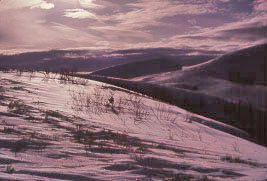 I find it amusing that the literate world has such a dim outlook on snow. Alas, there must be few skiers among the poets. Unlike Emerson, most poets and writers portray snow and winter as a time of gloom, not as a time to celebrate beauty. Snow is often symbol of desperation and depression. "Now is the winter of our discontent" moaned Shakespeare in King Richard the Third. And then in King Henry, he raged "Barren winter, with his wrathful nipping cold."
I find it amusing that the literate world has such a dim outlook on snow. Alas, there must be few skiers among the poets. Unlike Emerson, most poets and writers portray snow and winter as a time of gloom, not as a time to celebrate beauty. Snow is often symbol of desperation and depression. "Now is the winter of our discontent" moaned Shakespeare in King Richard the Third. And then in King Henry, he raged "Barren winter, with his wrathful nipping cold."
Such pronouncements are not limited to men. "There's a certain Slant of light," wrote Emily Dickinson, "Winter Afternoons / That oppresses, like the Heft / Of Cathedral Tunes." Even more oppressive than the heft of cathedral tunes is the picture painted by Christina Georgina Rossetti of a snow storm:
In the bleak midwinter
Frosty wind made moan,
Earth stood hard as iron,
Water like a stone;
Snow had fallen, snow on snow,
Snow on snow,
In the bleak midwinter,
Long ago.
Rudyard Kipling was anything but mournful in his writing; nevertheless, he wasn't enamored with the idea of winter: "Never again will I spend another winter in this accursed bucketshop of a refrigerator called England." What a clever parting quip to impress friends! "Never again," you say with great flourish, throwing a heavy woolen scarf around your neck, "will I spend another winter in this accursed bucketshop of a refrigerator called (insert the name of your state here.) " To be perfectly honest, I do have to admit that there were times when I could have easily inserted the word "Minnesota" in the blank.
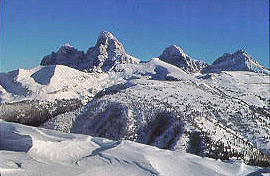 While winter weather and snow are depressing to many writers, it is also, interestingly enough, a symbol of purity. In the bible, Isaiah says: "Come now, and let us reason together…though your sins be as scarlet, they shall be as white as snow." Shakespeare, who is no snow lover, uses it when he speaks of chastity: "Be thou as chaste as ice, as pure as snow." It seems strange that a symbol for depression is also used as a symbol for purity and chastity. Perhaps being a virgin and righteous is depressing. But I don't think I'll go there. I'll let philosophers and theologians tackle that one.
While winter weather and snow are depressing to many writers, it is also, interestingly enough, a symbol of purity. In the bible, Isaiah says: "Come now, and let us reason together…though your sins be as scarlet, they shall be as white as snow." Shakespeare, who is no snow lover, uses it when he speaks of chastity: "Be thou as chaste as ice, as pure as snow." It seems strange that a symbol for depression is also used as a symbol for purity and chastity. Perhaps being a virgin and righteous is depressing. But I don't think I'll go there. I'll let philosophers and theologians tackle that one.
There are exceptions, of course, like Robert Frost. (Anybody with a name like Frost had to have a soft spot for snow.) In one of his most well known poems, Stopping By Woods on A Snowy Evening, he pauses and watches the woods "fill up with snow." The wood's beauty, nature's work of art, has drawn him and he seems to be lost in quiet contemplation, but then home and the responsibilities of life tug at him and eventually pull him away:
The woods are lovely, dark and deep.
But I have promises to keep,
And miles to go before I sleep,
And miles to go before I sleep.
It's those promises that always take us away. We've been out skiing or snowshoeing and have become entranced by the winter scenery and suddenly realize that the time has gotten beyond us and we must return. We eventually return, of course, but the beauty of that experience stays, tucked away in our memory, and we are the better for it.
That's certainly the way I feel about my first memorable moonlight ski. Although I wanted to wander for hours, it was cold that night, and, admittedly, my body was pretty tired from falling much of the day. The demands of life--of rest and warmth--in the end, can't be denied, and I turned around and headed back to camp. Nearing camp, I couldn't resist a quick run down a small hill. As I flew down it--without falling this time!--powder flew off from my skis in two plumes of silver confetti.
Moments like that make it all worthwhile. Let the poets whine and stew in their melancholy. We would rather celebrate: Arrives the snow!
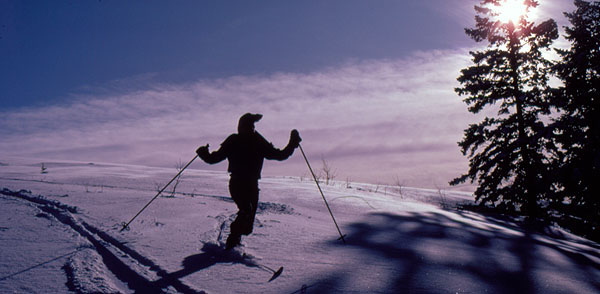
END
A Great Read...
|
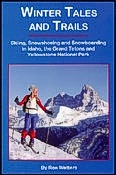 |
The book is truly a classic, one reviewer calling it the "standard by which other guidebooks are judged." Click here for more information on Winter Tales and Trails. . |
|

